Are you trying to learn something new and looking for ways to learn it faster?
Maybe you find learning to be a struggle, because you put in the time but nothing seems to stick?
Or worse, does the thought of having to try and learn or revise, make you want to curl up under your duvet until the last minute, and then you have to cram?
Well, good news!
In this article, I'm going to cover some of the best ways to learn anything new, along with ways to overcome the most common problems that people face when trying to learn anything new. All backed in science and hard won experience.
So let’s dive in…
Find your real reason why
Motivation is great until times get tough.
Which is why you need to go beyond the surface reasons of why you want to learn or achieve something, and look for the deeper meaning behind it. This way you'll be far more likely to stick to your goals (and learn what you want) when things become harder.
For example
Let's say you want to learn to code because it pays well. That's a pretty good motivator until you're doing tutorials after work, and the new Netflix show comes out.
So what can you do?
Simple. You tie it to that reason of why you started in the first place. Maybe you need the money so you can buy your first home with your partner. And just like that, you'll now stick to the task even when the motivation and excitement dips.
So before you do anything else:
Find your own real reason that you want to learn this behind the reason you might tell others
Imagine your life once this is completed. What does it look like? How do you feel? Describe your day
Then, go ahead and imagine you future if you would fail. What would your life be like 6 months from now if you don’t learn this thing? What caused you to fail?
Once you have the answers to these questions, go ahead and write them down to review later. It helps to not only get clear on this now, but use it as a reminder when working.
Do this now: Create a Google doc with your answers on it and then take a screenshot and set it as your background/screensaver. Maybe even print it out and put it on your desk so you see it every day.
It might not seem like much, but by creating this Google doc, you'll now be 91% more likely you actually take advantage of this post and the other tips in it.
Identity creates action
Humans are weird creatures. Thanks to brain chemistry and social dynamics, we do strange things, and one of those is a commitment to ‘self-identity’.
“I wear these clothes because I like X”, and it also works in the other direction. “Because I like X, I wear these clothes”.
This commitment to self-identity is simply helping us to stand out and find our tribe.

Because of that though, we don’t like to contradict ourselves. We won’t wear something else because it breaks who we are.
The cool thing is, we can use this commitment to self-identity to our advantage:
How?
Well, rather than say “I am learning to code”, start referring to yourself as a coder instead.
It’s such a small thing but this change of moving from being the same person you are now who is learning X topic, and instead identifying as who you want to become, will get you to follow through on learning this new thing.
Better still, it will help you to associate and do the things that you know those people already do.
A lot of people call this "faking it 'till you make it", but it really does work. Not only is it a trigger in your brain to start to take the right actions, but once you take those actions enough, you'll change.
For example
I'm a fit and healthy person
Healthy people workout daily
And so by 'faking it' that you are that type of person, you'll then take the action i.e working out daily. Which then causes you to become the healthy person.
See the difference?
Become the person you want to be, simply by identifying as it now and then making that new identity become a driver in the actions you take.
All major changes in life, such as learning new things, are life changes. You can’t become this new thing while staying the old thing. You need to become a new person. This means a change in habits, actions, and thoughts.
So go ahead and open that Google doc again and write your own identity statement.
I am X
I do X things
Simple.
Then, you can use self-identity again and take it a step further…
Set your intention
Another super small thing, but again, it works to help us keep on the path.
Setting the intentions of:
What you want to do
How you’re going to do it
And when you’re doing it
Will make you far more likely to follow through on a task.
For example
In a study on creating habits and follow through by Harvard University, they found that people who set their intentions of when, how, and where they would exercise, were far more likely to actually exercise each week and form the habit.
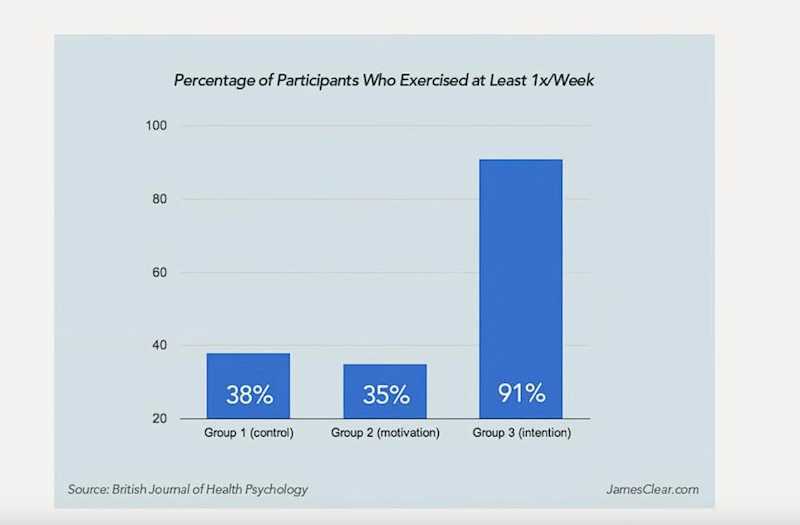
Group 1 was simply asked to exercise each week, and track if they did or didn’t do it. This was the control group to see how people would follow through on willpower alone.
Group 2 was asked to do the same, but were given a motivational speech and tried to connect the end result with the habit of working out. They actually exercised less than the control group (possibly because they were goal focused but more on that in a second).
Group 3 was given the same speech, but was also asked to simply write down their intentions of how this would work (when, where, and how will you exercise).
“I will do X minutes of exercise, on Y day at Z location.”
This alone caused 91% of the group to follow through and exercise each week.
Why? It comes back to self-identity we talked about already. We don’t want to contradict ourselves and the actions we’ve committed to, if possible.
So for your next task, head to that Google doc you created and write the first draft of your intentions now.
What you will do
When you'll do it
How you'll do it
Don't worry, I'm not going anywhere. I'll be right here once you're done.
Did it? Nice work. By now you should have:
Your core motivational drivers and real reason why
What your life will be like if you succeed or fail
Who you are when you fake it and what that the actions are that this person would take
And a time and date of when you'll take that action
You may need to edit it in a second with some more information, but it’s good to get clear on this early.
Plan your project before you start
OK so right now you’re probably incredibly motivated, but hold off on starting to learn just yet, because you need to strategize first.
Just like creating a workout plan before you head to the gym, you need to figure out just what your plan of attack is for your goal and what you want to learn. (There’s nothing worse than joining a gym for the first time in January, and then being overwhelmed with where to start and what to work out).
So go ahead and look at your goal and answer the following:
What is your end goal?
How will you know when you have achieved this?
What are the major milestones to achieve this?
What are the steps for each milestone?
What actions do you need to take to complete these steps?
For example
If you want to learn HTML, CSS, JavaScript and get hired as a developer then you need to find out what that actually means and looks like for you:
How will you know once you’ve ‘learned’ HTML, CSS, JavaScript?
Is there a set level of competence?
Are there challenges you can take?
Should you build projects? If so, which ones? How many?
Are there specific topics or areas inside JavaScript that you should know and learn?
Do you need to know absolutely everything about the language or are there certain things that take priority?
It doesn't need to be perfect before you start. But by asking these questions and breaking down what you want to achieve will make it much easier to learn. This way you can have a roadmap of what you need to learn.
Sidenote: This is exactly what I did when I first taught myself how to code.
I spent the first month avoiding any coding tutorials or programming courses or books. Instead, I spent this month figuring out what would be the best way for me to learn code and get hired as efficiently as possible. Which meant I learned to code and got hired 5 months later, so trust me - this works.
You don’t need to go too crazy with the research, otherwise you might over complicate things and get overwhelmed.
The key is to find roadmaps by people who've already done what you want to achieve. That way you can simply copy their steps and not have to figure it all out yourself.
For example
Here's the path I would recommend if you want to become a Web Developer in 2026, based on everything I know you need and cutting out everything you don't.
Become a Become a Fullstack Web Developer
13 milestones 9 courses
Step-by-step roadmap where you'll learn to code and build a portfolio.
Curated curriculum of courses, workshops, challenges, projects, and action items.
Become a Become a Fullstack Web Developer from scratch and actually get hired.
Earn on average per year:
$115,887
US salary data collected from Indeed, LinkedIn, and Web3.career 2026.
With any roadmap though, just make sure that the person sharing it knows what they're talking about.
It's easy to get tricked by people just trying to sell you or get overwhelmed with so much advice out there. If you go this route, pick 2-3 people that seem credible to get a few different viewpoints.
An even better strategy? Find and speak to 2-3 people who have recently reached the goal you want to reach (ex: got hired as a self-taught programmer) and ask them what their "roadmap" looked like and what they would do the same or differently if they had to start from scratch.
If you have the financial resources, consider taking a course on what you want to learn. Check the reviews and if there is a free trial or money back guarantee so you can make sure it's a good fit.
The benefit of taking self-directed courses is that a good course already has all that in mind. They know what you need to learn and get you to build the right projects, while also helping you to learn in a logical system of progression.
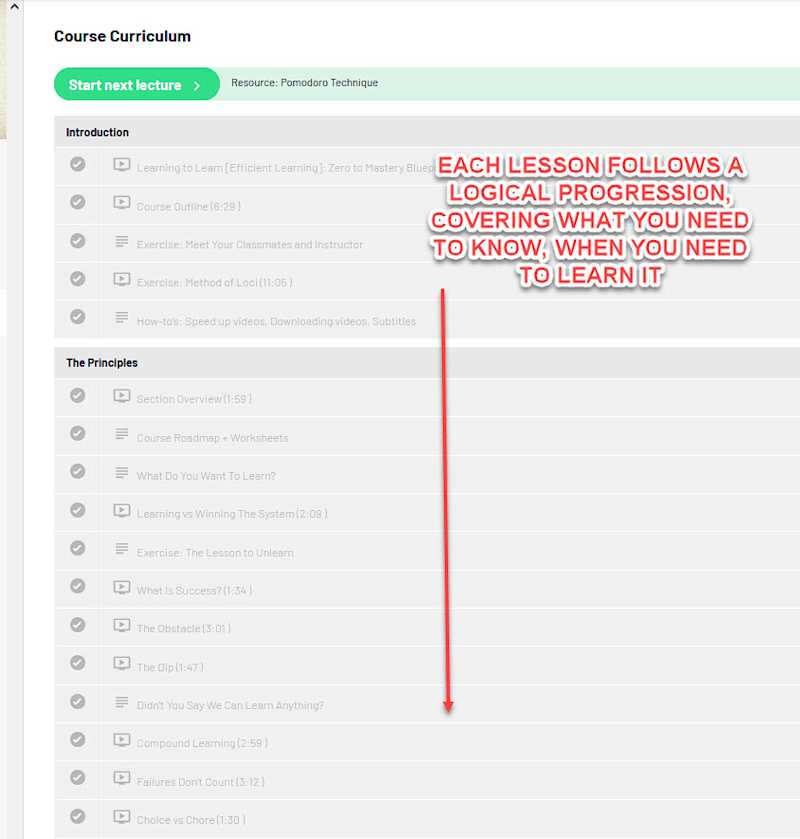
It can seriously fast-track your learning path!
However, if you decide to try and figure it out yourself, just make sure to mind-map it all out like we did earlier, but in more detail:
The end goal
The sections or ‘milestones’
What goes into each section
The best path to learn each of them. I.e should you learn how JavaScript works first, or how to build with it?
So go ahead now and create your roadmap. This way you know what to learn in total, what to learn first, and how to assess your own progress.
As a bonus, you can check things off as you go which always feels great.
Think in systems
The problem with goals is that they are a binary method of tracking success.
You’ve either learned the thing, or you don’t know it yet, and it’s the same metric every day when you’re working on a larger goal, which sucks.
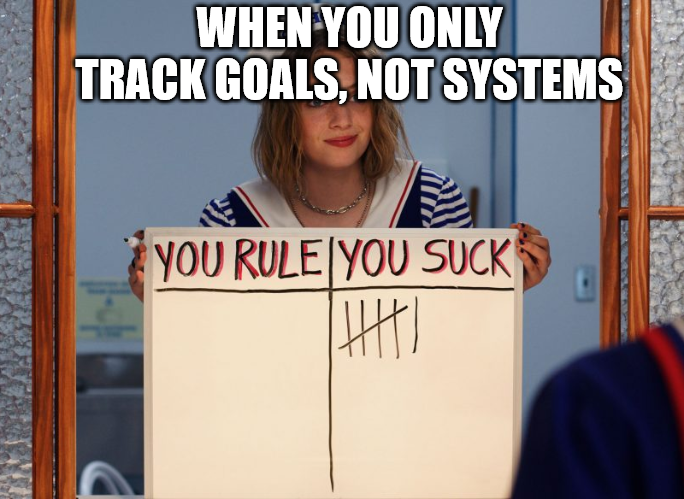
This can cause you to be disappointed that you haven’t achieved your goal, and worse, focus can even cause depression when you reach the goal as it’s no longer there as a motivator.
Weird huh?
If that’s not bad enough, goal thinking can be overwhelming. We know what the end result is and the enormity of the task, and we procrastinate and get anxious, causing us to not even start!
So how can we get past this?
Well, the trick that professional athletes use to plan their path for success is to create daily systems and track those instead of their goals.
They map out what they need to do to achieve their end goal into a daily task, and then track that instead.
For example
If you want to win the 1500m sprint, you need to get faster. The key however is to make sure you train each day, eat well and sleep, and so they track and measure each of these things.
Sure they still need to break down what they need to do for each day, but they are tracking the inputs required to achieve the output (aka the goal of winning the 1500m sprint).
Measure and track the inputs because these are what you have direct control over.

You need to do the same and create a system for your own goal. You’ve already started that with the roadmap planning in the last tip, but now you can break it down even further into a system of what to do and when.
Break down the milestones, what days you’ll work on each, and then simply follow that system focus each day.
If you’re working online, then Asana is a good tool for planning projects for free.
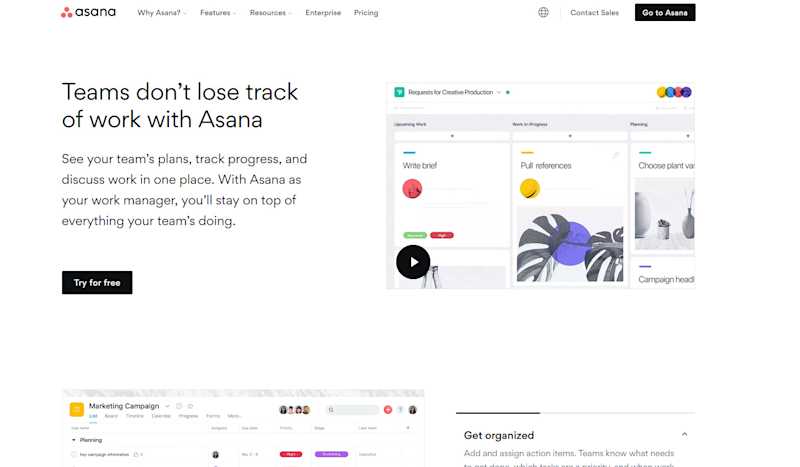
Take a quick break from reading this post and go do it:
Add in your project
Add each section and then the tasks
Then you can set dates and times for what you want to work on
Decided to stick with me to the end for now? Well you're in for a treat, because these next 2 tips will help you a lot…
Make it easy to win
A major problem people have with learning something new is that they try and take on too much at once. They want to lose 2kgs each week or learn a programming language in a month.
It might be possible in theory, but more often than not it's just too much and becomes overwhelming.
This either means that you never start because there’s just not enough time or the change is too large or worse, you do start at this intensity but can’t keep up the momentum and then feel like you’ve failed and you quit.
Instead, give yourself one small success metric that ties into the end goal and use that as a marker of daily success. Ideally, it should be something that initiates that end action and makes you say “Today was a success, and I moved forward”.
For example
If your goal is learning to code: Did I log in and start learning for at least 10 minutes? ✅
If your goal is losing weight: Did I show up to my workout class today? ✅
Etc
Having this small win each day will make you keep going when times are good and bad. Better still, start tracking those small wins…
Don’t break the streak!
Here’s another easy tip for both motivation to work, and to help you stay on track. All you need to do , is start tracking each day that you achieve this small win, and tick it off.
You can use a calendar or an app or whatever works for you. The trick is to keep it somewhere where you can always see it. On the fridge or as part of your home screen when your PC loads up.
All it takes is doing that task, getting that win and ticking the box, but soon you’ll never want to miss one. It’s such a proven method for success that we built streak tracking into our training platform:
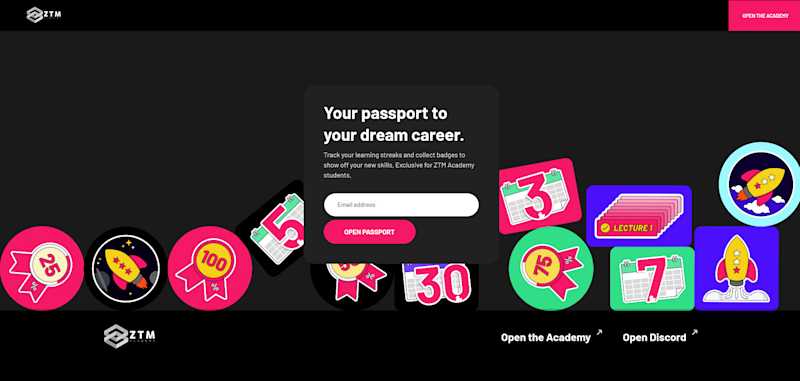
The user logs in and then it tells them each day they’ve logged in and completed a lesson.

It helps rank them amongst their peers, and gives awards and badges for specific milestone markers. (Gamification and small rewards are great for ongoing motivation of long term goals).

Duolingo does the exact same thing with their users. They help them not only set a goal, but set up a small win for each day that they can track as a success metric.

Streaks are an incredibly powerful tool for keeping you on track. Just don’t beat yourself up if you miss a day. Instead, make sure that you never miss 2 days in a row.
A sign of high performers is NOT that they never fail. Because they do, and they miss streaks. However, they get back up and running faster than everyone else.
You don’t need to make up the time or practice for twice as long. Keep that one small success metric tracked and just try to never miss 2 days in a row. If you do that, then your results will compound over time and blow your mind how much you’ve learned and changed in 6-12 months.
In fact, learning consistently for 10 minutes a day is way more likely to lead to success than for 70 minutes once a week.
Make it simple to take action
A huge factor in both good and bad habits is our environment. Does it help us do the right thing or the wrong thing?
For example
In a 2012 study on obesity and availability of fast food, they found that if you had 5 or more fast food locations in a 1 mile radius of your house, then you were more than 30% more likely to eat at them then if you had less than 4 locations near you.
Your environment really does shape your actions and choices!
With this in mind, we want to create the ideal learning environment for success so we can trigger positive actions to help you succeed, and remove the things that will make you fail.
Remove distraction triggers
It's so easy to check our phones for a second and then look up 30 minutes later, and forget what we were doing.
So don’t use willpower alone. Cut out the option entirely instead.
Download and install site blockers for both your phone and computer. These restrict your access helping you stay focused
Remove social media from your phone. The constant alerts make it very hard to stay on track
Clear your desk of anything not related to what you are doing right now
Keep your phone in another room. Even seeing the phone lying there can cause an impulse trigger to want to check it, making it harder to concentrate
Get noise canceling headphones to cut out excess noise
Add correct action triggers
Likewise, you can add positive triggers to your environment to help you learn:
If you use a notepad for learning, have it on your desk ready and open to where you are continuing. Seeing this can help remind you to start
Set your homepage for your project management, streak tracking, and learning materials only. You can see what you need to learn, get that small win and tick it off, and then start learning!
Add reminders in places where you might be distracted. Sticky notes on tv remotes or fridges. Make a screensaver on your pc and phone to learn
Forming a new good habit is a lot easier when you connect it to something that you already do each day.
For example
If you want to exercise in the morning, then leaving your gym gear in the bathroom near your toothbrush will help trigger you to put it on and then head out the door immediately after brushing your teeth.
It seems simple but because you’re already conditioned to brush your teeth at the same time each day, it makes the new task become far less mental bandwidth to get started.
Remember:
The goal is what we want at the end
The roadmap gives us the path to a goal
Triggers are what starts it all. It’s how we start forming habits. Both good and bad
Habits are how we start taking action on systems
Systems are what we do daily to reach goals
Streaks are how we keep following systems and don’t stop
Far too many people focus on just the goal, but even when they buy a course roadmap or create a system, they still don’t create or stick to the habits that get them working on those systems.
Build your environment for success.
Everything you’re doing so far is all tied together to help you win, even when it feels like you’re losing…
It will suck but it gets better
Whenever we learn something new, there will be times when it just feels too difficult or complex. The information doesn't quite make sense yet, and there’s this gap between where we want to be and where we are now.
This can make a lot of people give up. Often not because the task is beyond them, but because their ego is bruised from not being good at something.
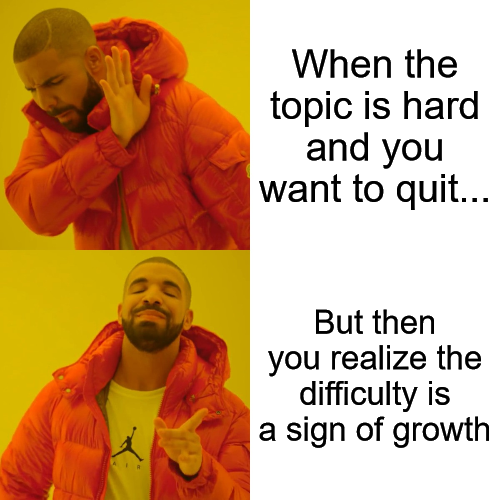
Reframe this situation so that when you get that feeling that this is hard and you suck, you instead realize that this must be something difficult so it must be important.
This difficulty is a signal of growth and change. That way, you’ll stick to it and keep learning!
The other cool thing about this reframing?
Because most people quit here, it means that you’re going to be learning something that increases your value in multiple ways. Not only are you learning this new topic, but your new level of perseverance and willingness to learn will increase, making all future learning even easier.
Don’t forget... failure is literally the scientific method.
We test something and see what happens. But only by learning what doesn’t work, do we then learn what actually works. Failure is part of growth.
So just treat it like a computer game and realize that you’re leveling up!
Accountability is key
Another super simple cheat code for sticking to any project is public accountability!
By setting your intention of what you're doing in front of your peers, this can cause you to stick to the end goal.
It works so well, that we get all our new users here at ZTM to do this in our Discord community. It helps them see other new people on the same path, and then share in their journeys and struggles.
There’s also a great movement in the coding community called 100 days of code.
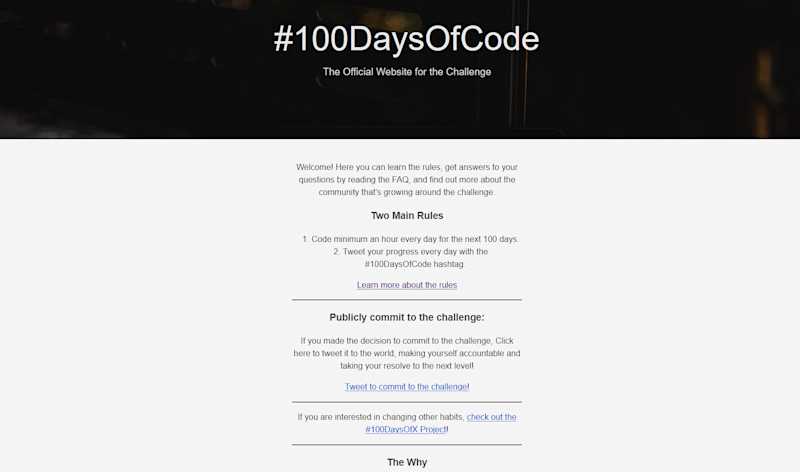
It works like this:
By sharing a screenshot of you coding each day, along with the hashtag #100daysofcode, you’re publicly showing all other members that you’re on the same path. You can even tag which day you’re on, what you’re doing, and more.
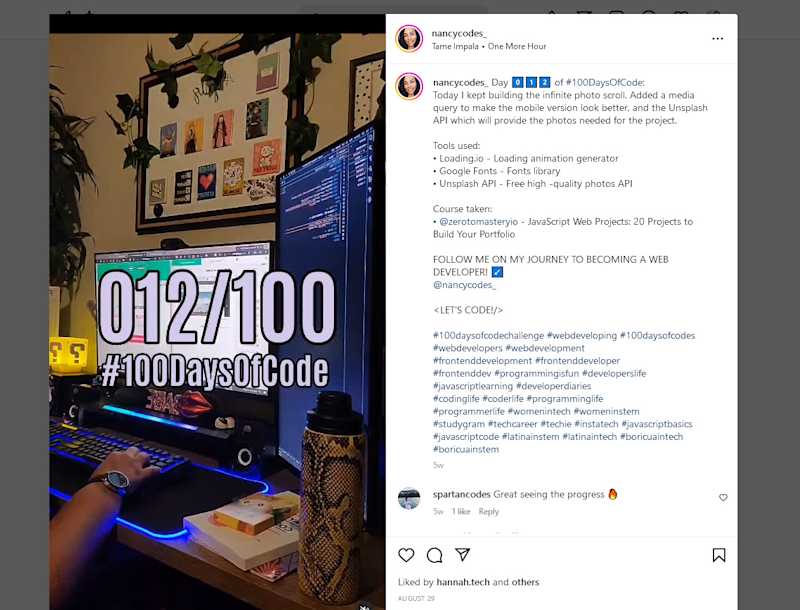
And because it takes around 90 days to form a new habit, if you can keep at it for all 100 in the challenge, then you'll be a far better coder by the end of it!
However, beware of false wins or feelings of accomplishment for simply sharing your plan.
What do I mean?
It can be very easy to get the same endorphin release for sharing what you’re going to do, as you would when you actually achieve your end goal. This can cause some people to share their goals, get a pat on the back, feel good and then never start them.
Don’t fall into this trap!
Alright. So we’ve covered a lot so far on systems and strategy and mental components, let’s look at some tips for the learning process itself…
Consistency beats cramming
Unless you’re some kind of wunderkind, I’m willing to bet $1,000 that you’ve crammed for an exam before.
You stay up all night consuming a mad concoction of energy drinks and nodoze, learn what you can, complete the exam and then immediately forget everything that you ever learned.
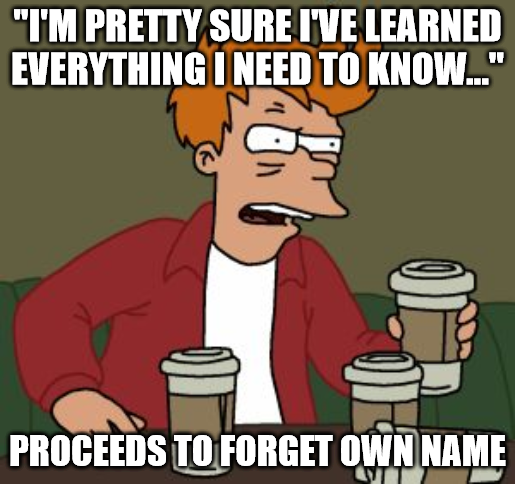
This type of learning can work in a pinch, but it’s not effective, because sure, it can help you pass a test but you never really learn the content.
The trick to learning the fastest and most efficiently, is to actually stagger your learning in short bursts over extended periods of time. It seems counterintuitive but doing less more often, creates new pathways in your brain that actually makes the information stick.
You see, unless we keep covering material often, we start to forget it over time:
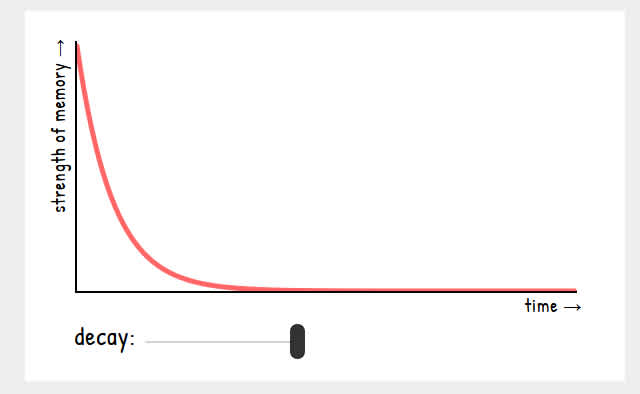
But the more often we recap and actively/deliberately practice it and talk about it, the longer it stays in the memory.
This is called ‘spaced repetition’.
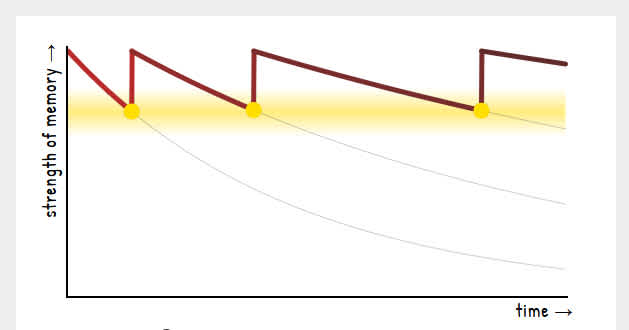
In fact, the more we do this, the stronger our neural pathways become and the easier it is to recall and associate this information with other facts and ideas.
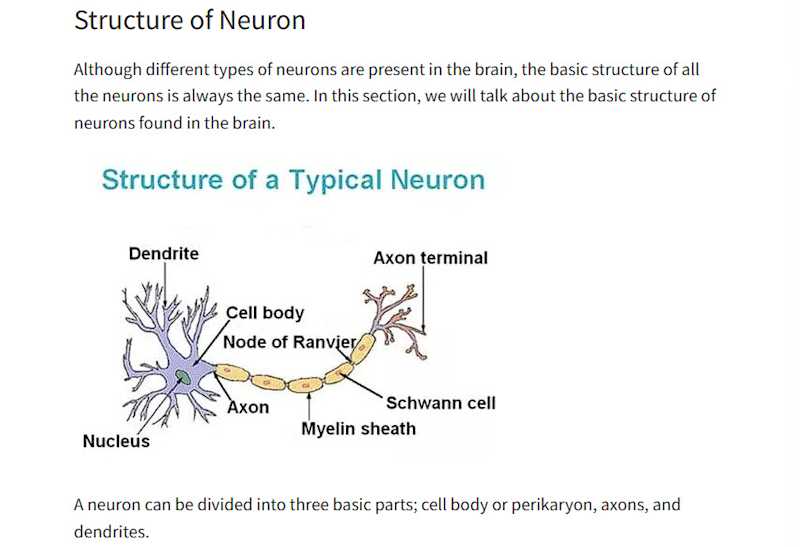
We even go from holding this information in short term recall to it becoming long term memories.
I cover all of this and more in my deep dive course on efficient learning, that I definitely recommend you check out.
But trust me, staggered learning is the cheat code you probably didn’t want, but have been looking for.
The best part of this approach?
There’s far less stress or anxiety when you stagger out your learning into short bursts. All it takes is 1-2 hours max per day (even less is fine to when you're just getting started), and it starts to compound.
Within 70 days, you’re already 100% better than you were when you started, in terms of both new knowledge and how much you’ve retained so far.
Also?
When you stop cramming as a method of ‘learning’, you can actually get some rest the night before…
Sleep is a secret weapon
No joke, getting enough sleep is like a cheat code for life.
A lack of it and you start making bad choices based on fear and survival. Exhaustion actually alters our brain chemistry and generally ruins your day. You have coffee to try and get through it but now you’re just caffeinated and still not performing correctly, just faster!
But when you do sleep, your brain builds pathways easier, helping you to create those connections between what you're currently learning and what you've learned so far.
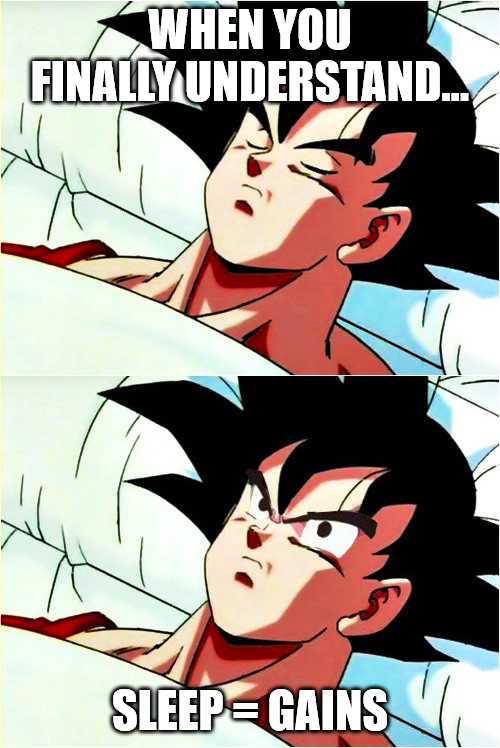
So why aren't you sleeping enough?
Probably because you're still in the cramming mindset perhaps?
Remember:
Cut off at the same time each night so that you have dedicated focus windows
And then get to bed early!
Use your focus zone
A key sign of a professional is knowing when to work and when to rest.
Trying to push through when you're exhausted just makes you more tired, but if you can figure out your optimum window for focus? Well then it’s like a superpower.
Some people are better in the mornings, others are night owls - the trick is learning when you work best and taking advantage of it.
Better still, use a tool or browser plugin such as a pomodoro timer to help you stay focused during those focus windows.

You set the timer for 25 mins and work, and then take a 5 minute break.
This helps the brain go from focus mode to diffuse mode, where it can rest and get ready for the next burst. Do that 4 times a day and you’ll be amazed how much you get done.
That being said, some days are harder than others to focus so be aware of your limits. If you’re struggling with learning or practicing something, not because it's complex but simply because your brain is tired, then take a break.
Go for a walk, exercise or do a mundane task such as washing the dishes.
This can help refill the tank and even help you to connect the dots on things you were struggling with, but without feeling bad and sitting at your computer the whole time.
Then when you have that aha moment, come back and smash out the lesson for the day!
Multitasker's get nowhere fast
Do you ever feel mentally tired sometimes while learning, and are not sure of the cause? Some days are fine but others seem far more difficult?
Well, you could be suffering from a lack of directed focus causing you to mentally fatigue much faster then usual.
The main culprit? Multi-tasking...
Often thought of as a way to get more done fast, multi-tasking has been proven to not only slow you down, but to cause you to tire out and be less efficient then if you just did each task in sequence.
Fun fact?
If you try to perform 2 cognitive tasks at the same time, then you’ll suffer a cognitive processing drop that's equivalent of going from a University level MBA student to an 8 year old.
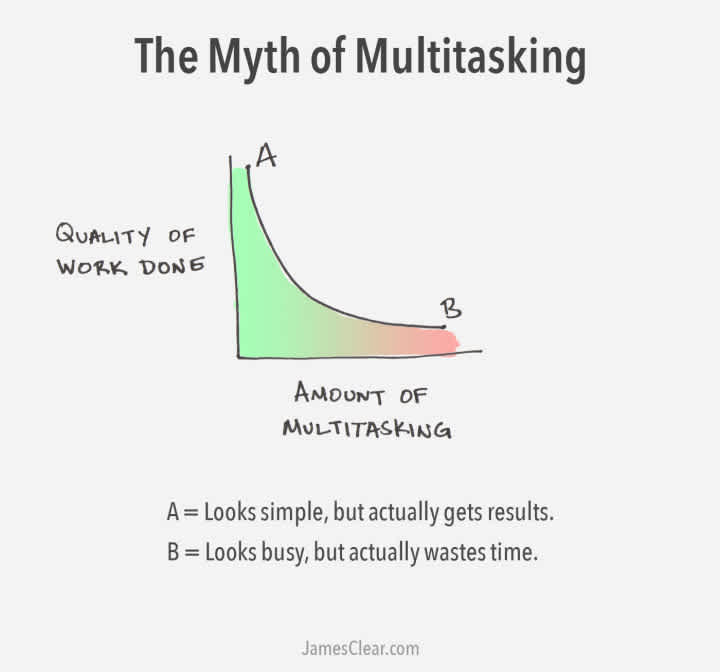
We just can't parallel process very well, so don’t do it.
If you want to learn more efficiently and not get tired as fast, close those tabs!
Learn by actively doing
There are 2 types of learning: active and passive.
A lot of self-directed learning fails because it’s passive. We only consume information such as this blog post or a YouTube, but unless we actively act on it, all we’re doing is acquiring short term knowledge.
You need to be actively applying and using that information if we want it to stick.
Writing notes
Recapping and recalling what you’ve covered
Explaining concepts out loud to yourself
Trying to teach someone else what you just learned
Solving problems
Actually writing code & building projects (vs. just watching tutorials)
And just generally using what you’re learning
If you want to learn French then practice speaking French. Recap the words you know, write down their translations, take tests, find a native speaker to speak with, etc.

This focused and deliberate practice is the best way to learn and retain any new information long-term.
Learn by teaching
We’ve talked about this technique before and it ties into the tip above.
The Feynman technique is named after Richard Fenyman, Nobel prize winning physicist who was both a genius but also great at explaining difficult concepts to people who had no background in an area.
The idea of course is that if you can explain an idea in simple terms, then you know it better. If you can’t explain it simply, then you don’t fully grasp the concepts yourself yet.

So by actively trying to understand and simplify a concept, and then teaching it to others, you understand the content better. Chat to friends and family, or even in your accountability community.
Helping others will help you.
Check your direction and course correct
Do you ever feel like you’re not going anywhere and just moving in circles? Well chances are that you’re right.
You see, without an ongoing system of action, feedback, and response, humans will often second guess decisions.
In fact, in a 2009 study by Max-Plankk University, they found that hikers without a method of finding a direction such as a compass or landmark, would simply walk in circles for hours.

There were 4 groups being tracked via GPS to map their movements.
Each one of them backtracked multiple times, apart from one. The difference? The sun came out after around 15 minutes and they followed it in the sky. (Notice how for the first 15 minutes they walk in an arc though!)
Any long term goal needs that action, feedback, response loop.
I recommend that once a week you check in with yourself and your progress:
Did you maintain your streak for the week?
Did you work on the one most important task?
How many times did you complete these tasks?
Can you recall the information now? (re-visit those weaker areas)
Can you pass a test on this topic?
It’s a small thing, but time passes fast and can easily run away from you. If you’re skipping any extra 1 or 2 days, you’ll soon start to see a pattern.
Likewise, if you’re doing well then you’ll start to see a pattern of progression. This is so important, becauce sometimes it feels like we’re not learning anything because everything we learn is new.
But once we look back and see everything that we’ve learned, then we can see our progress.
Make it rewarding!
Another secret for long-term goals is to reward yourself as you go, not just at the end.
It’s ok to look forward to the end goal of a new job or home, but it’s also important to give positive reinforcement for when you're making progress. Small wins for milestones etc.

Celebrate and reward yourself for those 7 day streaks and milestones and you’ll want to keep going.
What to do when you get bored of learning?
We’ve actually been covering a lot of elements so far that can help with boredom. Hopefully you wont suffer from it often, but if you get stuck just remember:
Try to get that one small win. Once you start you’ll find it much easier to keep going
Reward yourself for your efforts
Go back and re-read your goals, intentions and reasons why. Re-light that fire!
Track what you’ve learned so far. It can be a good pick me up when you see your progress
Take breaks. Diffuse thinking on the topic is good if that's all you can manage today
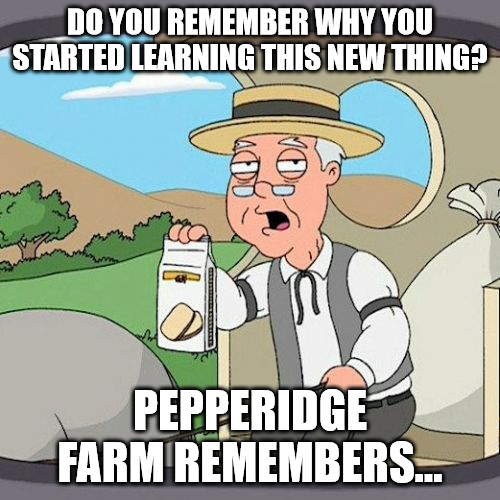
The key thing is, make sure you don’t beat yourself up about it.
Start learning that new skill today!
We’ve covered a lot of tips here on how to learn far faster and more efficiently. If you want even more tips and detailed video guides on how to learn more effectively, then check out our course here.
Otherwise, go ahead and follow through and take action on this guide. Find your reason why, build that roadmap, create your system and start learning now!
Best articles. Best resources. Only for ZTM subscribers.
If you enjoyed Andrei's post and want to get more like it in the future, subscribe below. By joining over 500,000 ZTM email subscribers, you'll receive exclusive ZTM posts, opportunities, and offers.
No spam ever, unsubscribe anytime
By the way, if you want to learn both technical and non-technical skills that you need to have a successful career in the tech industry, then come join us as a member of Zero To Mastery.

![Learning to Learn [Efficient Learning]](https://images.ctfassets.net/aq13lwl6616q/6VWcUgLgG0SU55ORlILe2S/e186361aeb48561bcd19ae6486577022/Learning_to_Learn.jpg?w=600&h=336&fl=progressive&q=50&fm=jpg&bg=transparent)
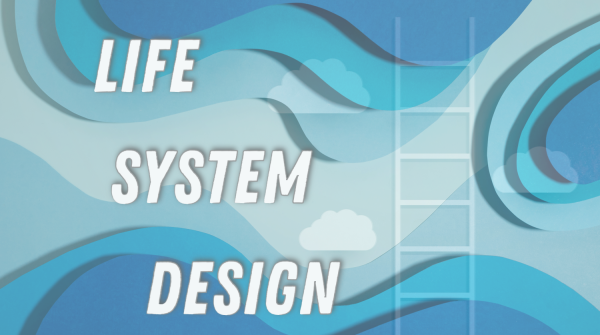
![Learning to Meditate [Productivity & Focus]](https://images.ctfassets.net/aq13lwl6616q/2a7NI2zgRFphCk8pnDHBYF/34433f9991c8952427f112d428014bc6/Meditation_Thumbnail_2-_Academy.png?w=600&h=335&q=50&fm=png&bg=transparent)



